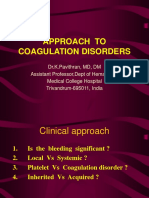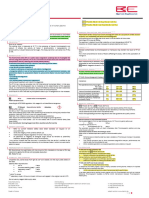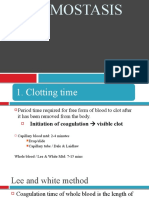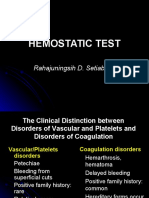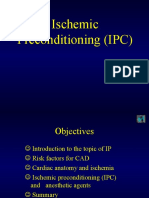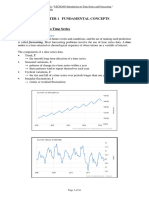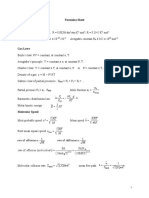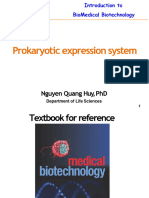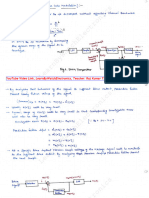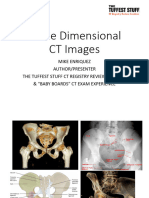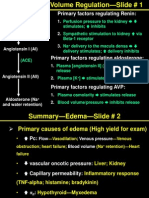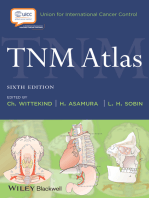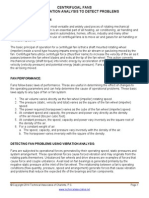0 ratings0% found this document useful (0 votes)
82 viewsHemostaza
Hemostaza
Uploaded by
Mischa Vlăsceanu1. Defects of primary hemostasis (platelet defects) cause bleeding immediately after trauma in superficial sites, while defects of secondary hemostasis (plasma protein defects) cause delayed bleeding in deep sites.
2. Physical findings in primary hemostasis defects include petechiae and ecchymoses, while secondary hemostasis defects cause hematomas and hemarthroses.
3. Defects of primary hemostasis usually have an autosomal dominant family history, while defects of secondary hemostasis often have an autosomal or X-linked recessive family history.
Copyright:
© All Rights Reserved
Available Formats
Download as DOCX, PDF, TXT or read online from Scribd
Hemostaza
Hemostaza
Uploaded by
Mischa Vlăsceanu0 ratings0% found this document useful (0 votes)
82 views7 pages1. Defects of primary hemostasis (platelet defects) cause bleeding immediately after trauma in superficial sites, while defects of secondary hemostasis (plasma protein defects) cause delayed bleeding in deep sites.
2. Physical findings in primary hemostasis defects include petechiae and ecchymoses, while secondary hemostasis defects cause hematomas and hemarthroses.
3. Defects of primary hemostasis usually have an autosomal dominant family history, while defects of secondary hemostasis often have an autosomal or X-linked recessive family history.
Original Description:
Hemostaza
Copyright
© © All Rights Reserved
Available Formats
DOCX, PDF, TXT or read online from Scribd
Share this document
Did you find this document useful?
Is this content inappropriate?
1. Defects of primary hemostasis (platelet defects) cause bleeding immediately after trauma in superficial sites, while defects of secondary hemostasis (plasma protein defects) cause delayed bleeding in deep sites.
2. Physical findings in primary hemostasis defects include petechiae and ecchymoses, while secondary hemostasis defects cause hematomas and hemarthroses.
3. Defects of primary hemostasis usually have an autosomal dominant family history, while defects of secondary hemostasis often have an autosomal or X-linked recessive family history.
Copyright:
© All Rights Reserved
Available Formats
Download as DOCX, PDF, TXT or read online from Scribd
Download as docx, pdf, or txt
0 ratings0% found this document useful (0 votes)
82 views7 pagesHemostaza
Hemostaza
Uploaded by
Mischa Vlăsceanu1. Defects of primary hemostasis (platelet defects) cause bleeding immediately after trauma in superficial sites, while defects of secondary hemostasis (plasma protein defects) cause delayed bleeding in deep sites.
2. Physical findings in primary hemostasis defects include petechiae and ecchymoses, while secondary hemostasis defects cause hematomas and hemarthroses.
3. Defects of primary hemostasis usually have an autosomal dominant family history, while defects of secondary hemostasis often have an autosomal or X-linked recessive family history.
Copyright:
© All Rights Reserved
Available Formats
Download as DOCX, PDF, TXT or read online from Scribd
Download as docx, pdf, or txt
You are on page 1of 7
Differences in the Clinical Manifestations of Disorders of Primary and Secondary Hemostasis
Manifestations Defects of Primary Hemostasis
(Platelet Defects)
Defects of Secondary Hemostasis (Plasma Protein
Defects)
Onset of bleeding after trauma Immediate Delayed (hours or days)
Sites of bleeding Superficial skin, mucous membranes, nose, gastrointestinal
and genitourinary tracts
Deep (joints, muscle, retroperitoneum)
Physical findings Petechiae, ecchymoses Hematomas, hemarthroses
Family history Autosomal dominant Autosomal or X-linked recessive
Response to therapy Immediate; local measures effective Requires sustained systemic therapy
EXPLORAREA HEMOSTAZEI PRIMARE
TESTELE DE SCREENING :
Timpul de sangerare - TS
Numararea placutelor sanguine
Primary Hemostatic (Platelet) Disorders
1. Defects of platelet adhesion
- von Willebrand's disease
- Bernard-Soulier syndrome (absence or dysfunction of GpIb/IX)
2. Defects of platelet aggregation
- Glanzmann's thrombasthenia (absence or dysfunction of GpIIb/IIIa)
3. Defects of platelet release
Decreased cyclooxygenase activity
- Drug-induced (aspirin, nonsteroidal anti-inflammatory agents)
- Congenital
Granule storage pool defects
- Congenital
- Acquired
Uremia
Platelet coating (e.g., penicillin or paraproteins)
4. Defect of platelet coagulant activity
- Scott's syndrome
Evaluation of Platelet Function
Bleeding time
Modified Ivy method
Skin incision (time to stop bleeding)
Global screen of platelet role in hemostasis
von Willebrand factor assays
vWF Ag (immunoassay of total vWF protein)
vWF R:Cof (bioassay of vWF that measures ability of patient plasma to support agglutination of normal platelets in the presence of ristocetin)
Factor VIII (coagulation assay of factor VIII bound and carried by plasma vWF)
Platelet aggregometry
Measures platelet aggregation in response to a panel of agonists, usually ADP, collagen, arachidonic acid, and epinephrine
Membrane glycoproteins
Presence of glycoproteins Ib-IX and IIb-IIIa can be measured using monoclonal antibodies and flow cytometry
Platelet granule content
Dense granules (electron microscopy or uptake and retention of radiolabeled serotonin)
Alpha granules (electron microscopy and/or immunoassays for platelet-associated proteins - vWF, fibrinogen, platelet factor four
EXPLORAREA HEMOSTAZEI SECUNDARE (COAGULAREA)
TESTE DE SCREENING :
TCG TC (aPTT)
TIMPUL DE PROTROMBINA (QUICK) = PT
TIMPUL DE TROMBINA
FIBRINOGENEMIA
Relationship between Secondary Hemostatic Disorders and Coagulation Test Abnormalities
Prolonged partial thromboplastin time (PTT)
No clinical bleeding (factors XII, HMWK, PK)
Mild or rare bleeding (factor XI)
Frequent, severe bleeding (factors VIII and IX)
Prolonged prothrombin time (PT)
Factor VII deficiency
Vitamin K deficiency - early
Warfarin anticoagulant ingestion
Prolonged PTT and PT
Factor II, V, or X deficiency
Vitamin K deficiency - late
Warfarin anticoagulant ingestion
Prolonged thrombin time (TT)
Mild or rare bleeding, afibrinogenemia
Frequent, severe bleeding, dysfibrinogenemia
Heparin-like inhibitors or heparin administration
Prolonged PT and/or PTT not corrected with normal plasma
Specific or nonspecific inhibitor syndromes
Clot solubility in 5 M urea
Factor XIII deficiency
Inhibitors or defective cross-linking
Rapid clot lysis
a2 plasmin inhibitor
Dg. diferential : deficit de FPC / deficit de VK
TESTUL KOLLER
DEFICIT FPC DEFICIT DE VK
APTT / PT APTT / PT
Administrare de VK (i.m.)
8 12 ore
APTT / PT (nu se corecteaza) APTT / PT = N (se corecteaza)
TEST KOLLER (-) TEST KOLLER (+)
EXPLORAREA FIBRINOLIZEI
TLCS
TLCE
D-DIMER
SEMNIFICATIA D-DIMERULUI
SINDROM FIBRINOLITIC SINDROM FIBRINOLITIC
PRIMAR SECUNDAR
APTT = N APTT
PT = N PT
TT = N TT
Fibrinogenemie (disproportionat) Fibrinogenemie
Tr-citopenie Tr-citopenie
TLCS, TLCE TLCS, TLCE
PDF +++ PDF +++
D-Dimer = N D-Dimer
You might also like
- Chemical Engineering Board Exam ReviewerDocument72 pagesChemical Engineering Board Exam ReviewerRichelle CharleneNo ratings yet
- Hemostaza LPDocument7 pagesHemostaza LPmischa_vlasceanuNo ratings yet
- Approach To Coagulation DisordersDocument20 pagesApproach To Coagulation DisordersTri P BukerNo ratings yet
- Disease & Def Patho/Mech Clinical S/S DX/ Tests/Labs TX NotesDocument11 pagesDisease & Def Patho/Mech Clinical S/S DX/ Tests/Labs TX NotesSara AshurstNo ratings yet
- Hemostatic Test: Rahajuningsih D. SetiabudyDocument17 pagesHemostatic Test: Rahajuningsih D. Setiabudyyuuna_wellerNo ratings yet
- CLG Chapter5 PDFDocument5 pagesCLG Chapter5 PDFIberisNo ratings yet
- Hemostaza LPDocument12 pagesHemostaza LPmoto24100% (1)
- Finals Topic-7 Hema-2 Mixing-Studies 3CDocument2 pagesFinals Topic-7 Hema-2 Mixing-Studies 3CFRANCIS ANDREI H. MIRANo ratings yet
- Ifu Be PT LiDocument2 pagesIfu Be PT LiTHE NYEMOTERSNo ratings yet
- Interpreting Thromboelastography (TEG) - RK - MDDocument1 pageInterpreting Thromboelastography (TEG) - RK - MDNicolas HortonNo ratings yet
- Test For Secondary HemostasisDocument32 pagesTest For Secondary Hemostasistitania izaNo ratings yet
- Coagulation DisordersDocument20 pagesCoagulation DisordersAnuj SharmaNo ratings yet
- Test For Secondary HemostasisDocument32 pagesTest For Secondary Hemostasistitania izaNo ratings yet
- REVALIDA COMPRE HEMA2LAB MIXING STUDIES UnivSantoTomasDocument4 pagesREVALIDA COMPRE HEMA2LAB MIXING STUDIES UnivSantoTomasJemimah CainoyNo ratings yet
- For Secondary: IeiviqstasisDocument68 pagesFor Secondary: IeiviqstasisMichelle San Miguel FeguroNo ratings yet
- Follow Up Tgl/Jam S O A PDocument2 pagesFollow Up Tgl/Jam S O A PGabriellaNo ratings yet
- AntiArrhythmic DrugsDocument7 pagesAntiArrhythmic DrugsKAZI RAHATNo ratings yet
- PT Aptt CoagulationDocument6 pagesPT Aptt Coagulationशिवराज शैटिNo ratings yet
- Hemostaticdisorders Associatedwith Hepatobiliarydisease: Cynthia R.L. WebsterDocument15 pagesHemostaticdisorders Associatedwith Hepatobiliarydisease: Cynthia R.L. WebsterJuan DuasoNo ratings yet
- RealMind MCL60 Cardiac Markers Brochure (2024.6.26)Document6 pagesRealMind MCL60 Cardiac Markers Brochure (2024.6.26)linjinxian444No ratings yet
- Hemostatic TestDocument21 pagesHemostatic TestVitrosa Yosepta SeraNo ratings yet
- Code Blue Resuscitation RecordDocument2 pagesCode Blue Resuscitation Recordjialuchen76No ratings yet
- Bleeding Time Clotting Time PT and PTT2Document40 pagesBleeding Time Clotting Time PT and PTT2forexeahubNo ratings yet
- Ischemic PreconditioningDocument36 pagesIschemic PreconditioninghirschmedNo ratings yet
- Uecm3243 Topic 1Document16 pagesUecm3243 Topic 1YU XUAN LEENo ratings yet
- ADK Final Version-UpdatedDocument135 pagesADK Final Version-UpdatedDaal ChawlNo ratings yet
- Formulae Sheet Fundamental Constants: R 0.08314 DM Bar K Mol R 0.08206 DM Atm K Mol R 8.314 J K MolDocument6 pagesFormulae Sheet Fundamental Constants: R 0.08314 DM Bar K Mol R 0.08206 DM Atm K Mol R 8.314 J K MolPauline NgNo ratings yet
- 2022L1Manipulation of Gene Expression in ProkaryotesDocument69 pages2022L1Manipulation of Gene Expression in Prokaryotesthuynt.work1601No ratings yet
- Cerebro Vascular AttackDocument10 pagesCerebro Vascular AttackKalyan Babu VakaNo ratings yet
- What's New 20dec2022 ( (Autorecovered-310036581311017056) )Document19 pagesWhat's New 20dec2022 ( (Autorecovered-310036581311017056) )Abir HarmouchNo ratings yet
- Coagulation Made EasyDocument27 pagesCoagulation Made EasyHaris Tan100% (1)
- Lab - Hemostasis Ilki - PalembangDocument24 pagesLab - Hemostasis Ilki - Palembangrisantosa9823No ratings yet
- Assess Extrinsic Pathway (Tissue Factor Pathway) Prothrombin Time / PT Test / INRDocument3 pagesAssess Extrinsic Pathway (Tissue Factor Pathway) Prothrombin Time / PT Test / INRKristin DouglasNo ratings yet
- Formula Sheet: Systolic DiastolicDocument3 pagesFormula Sheet: Systolic DiastolicJames LaiNo ratings yet
- Electrolyte ImbalanceDocument4 pagesElectrolyte ImbalanceBharathbushan V MandiriNo ratings yet
- Reverse Transcription-Polymerase Chain Reaction: An Overview of The Technique and Its ApplicationsDocument17 pagesReverse Transcription-Polymerase Chain Reaction: An Overview of The Technique and Its ApplicationsItzelOchoaNo ratings yet
- Think Coag Think Tcoag: Catalogue Your Coagulation CompanyDocument32 pagesThink Coag Think Tcoag: Catalogue Your Coagulation CompanysandraNo ratings yet
- Advances in The Diagnosis and Treatment of ThrombocytopeniaDocument50 pagesAdvances in The Diagnosis and Treatment of ThrombocytopeniaLetnanCapungNo ratings yet
- 75 DPCMDocument3 pages75 DPCMjadounsaakshaNo ratings yet
- Massive Transfusion Phone Log INITIAL PHONE CALL (MP Activation Call)Document1 pageMassive Transfusion Phone Log INITIAL PHONE CALL (MP Activation Call)Jack WyattNo ratings yet
- Queueing SystemDocument67 pagesQueueing SystembalwantNo ratings yet
- Coagulation and HemostasisDocument72 pagesCoagulation and HemostasisBiniyam AsratNo ratings yet
- BTCTDocument6 pagesBTCTnoha83No ratings yet
- Drug Moa PK Use Se Ci Blood Coagulation: AnticoagulantsDocument4 pagesDrug Moa PK Use Se Ci Blood Coagulation: AnticoagulantsYusoff RamdzanNo ratings yet
- Coagulation Disorders-First Aid Book: SS DX TXDocument6 pagesCoagulation Disorders-First Aid Book: SS DX TXMAINo ratings yet
- Echocardiography Evaluation For The Tricuspid ValveDocument48 pagesEchocardiography Evaluation For The Tricuspid ValveSofia KusumadewiNo ratings yet
- Mixing Studies 1pp 08-13-15.pptx 0 PDFDocument49 pagesMixing Studies 1pp 08-13-15.pptx 0 PDFKholifah LintangNo ratings yet
- Coag Made EasyDocument27 pagesCoag Made Easyniko hizkiaNo ratings yet
- PDF Nursing Care PlanDocument16 pagesPDF Nursing Care PlanMichael MabiniNo ratings yet
- Hemostasis - Coagulation NoteDocument2 pagesHemostasis - Coagulation NoteSanjib BhuniaNo ratings yet
- October 31,2019: TH TH TH THDocument4 pagesOctober 31,2019: TH TH TH THYoussry JaranillaNo ratings yet
- Role of Bleeding Time and Clotting Time in Preoperative Hemostasis EvaluationDocument7 pagesRole of Bleeding Time and Clotting Time in Preoperative Hemostasis EvaluationAfin WiraNo ratings yet
- Cardiac PanelDocument6 pagesCardiac Panellinjinxian444No ratings yet
- Recent Therapeutic Advances in ES-SCLC: Dr. Andika Chandra Putra, PH.D, SP.P (K)Document19 pagesRecent Therapeutic Advances in ES-SCLC: Dr. Andika Chandra Putra, PH.D, SP.P (K)dicky wahyudiNo ratings yet
- Service Manual Humaclot ProDocument8 pagesService Manual Humaclot ProHuy Trung GiápNo ratings yet
- XN Result InterpretationDocument63 pagesXN Result InterpretationMarcellia Angelina100% (2)
- 3 D Images AnatomyDocument25 pages3 D Images AnatomyAreej AwadNo ratings yet
- Physiology Slides UsmleDocument46 pagesPhysiology Slides Usmlejustseas100% (1)
- Follow Up Pasien PscbaDocument10 pagesFollow Up Pasien PscbaDexzalNo ratings yet
- Essential Cardiac Electrophysiology: The Self-Assessment ApproachFrom EverandEssential Cardiac Electrophysiology: The Self-Assessment ApproachNo ratings yet
- PPTDocument38 pagesPPTLouis rajNo ratings yet
- Have Mercy On Us AutosavedDocument11 pagesHave Mercy On Us AutosavedMyrel Cedron TucioNo ratings yet
- Power Power Point PresentationDocument15 pagesPower Power Point PresentationShashie Mae BalanzaNo ratings yet
- (With Price) : Electronic KeyboardDocument30 pages(With Price) : Electronic KeyboardMauricioCostadeCarvalhoNo ratings yet
- 3SV SubmittalDocument2 pages3SV SubmittalBilly Isea DenaroNo ratings yet
- Performance Task 1Document3 pagesPerformance Task 1Diana CortezNo ratings yet
- Olanzapine Vs AripiprazoleDocument8 pagesOlanzapine Vs AripiprazoleDivaviyaNo ratings yet
- Service Manual: Dishdrawer™ DishwasherDocument55 pagesService Manual: Dishdrawer™ DishwashermosheNo ratings yet
- Post Graduate Diploma in Textile ManagementDocument10 pagesPost Graduate Diploma in Textile ManagementsurajyellowkiteNo ratings yet
- Research Methodology Project-1Document19 pagesResearch Methodology Project-1sss0% (2)
- Vaginal ItchingDocument2 pagesVaginal ItchingHervis Francisco FantiniNo ratings yet
- Print NumericalDocument23 pagesPrint Numericalsreekantha reddyNo ratings yet
- DvdavkjkDocument82 pagesDvdavkjkNajeebuddin AhmedNo ratings yet
- BRO Home Appliances enDocument11 pagesBRO Home Appliances enKhaled Sid Ahmed AbderahimNo ratings yet
- Analisis Kuantitatif Sediaan Obat DGN SpektrofluorometriDocument71 pagesAnalisis Kuantitatif Sediaan Obat DGN SpektrofluorometrideeNo ratings yet
- History: Wild AncestorsDocument2 pagesHistory: Wild AncestorspriyankaNo ratings yet
- Alonzo Ramos Factual ResumeDocument4 pagesAlonzo Ramos Factual ResumeThe Dallas Morning NewsNo ratings yet
- CSMT To NagpurDocument2 pagesCSMT To Nagpur39 - Deep MandokarNo ratings yet
- EXAMEN PARCIAL N°2 CUESTIONARIO - Revisión Del Intento FinalDocument6 pagesEXAMEN PARCIAL N°2 CUESTIONARIO - Revisión Del Intento FinalcladavidNo ratings yet
- Centrifugal Fans Using Vibration Analysis To Detect ProblemsDocument3 pagesCentrifugal Fans Using Vibration Analysis To Detect ProblemsGivon Da Anneista100% (2)
- Technical and Operating Instructions Manual Along With Cpl/PilDocument13 pagesTechnical and Operating Instructions Manual Along With Cpl/PilCidhin NairNo ratings yet
- Quiz Exercises 9 Reported Speech 9Document2 pagesQuiz Exercises 9 Reported Speech 9Joséphine NancasseNo ratings yet
- Safety Data Sheet CCM Polymers SDN BHD (363880-D)Document10 pagesSafety Data Sheet CCM Polymers SDN BHD (363880-D)Bo'im ZadNo ratings yet
- CIGRE SC B5 2011 104 Choosing and Using Tools Throughout The LifecycleDocument8 pagesCIGRE SC B5 2011 104 Choosing and Using Tools Throughout The Lifecycleraghavendran raghuNo ratings yet
- Danica LDR PanelDocument2 pagesDanica LDR PaneldanielbustNo ratings yet
- Raging Swan Dungeon Dressing Chests 2.0Document12 pagesRaging Swan Dungeon Dressing Chests 2.0Alessandro SurraNo ratings yet
- Cisco Networking Interview QuestionsDocument8 pagesCisco Networking Interview Questionsajit8279No ratings yet
- New Road Pasir Ris MallDocument1 pageNew Road Pasir Ris MallLee CSNo ratings yet
- 比較nkc 9 and Amberlyst MainDocument11 pages比較nkc 9 and Amberlyst Maingg oggNo ratings yet


